I have been in love with grasses for a long time. I can pinpoint the day, more than 25 years ago, with a botanist at Ring Mountain Nature Conservancy Preserve, where I wondered why these grasses she was so keen on having me document where not garden plants. I have learned a lot, a whole lot since then.
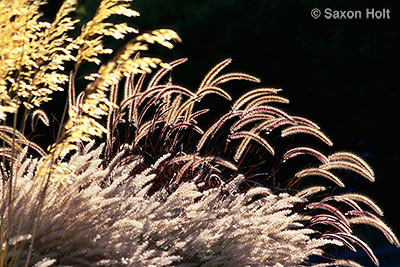
Pennisetum backlit in Ring Mountain garden
A huge opportunity presented itself to me when Storey Publishing asked me and Gardening Gone Wild’s very own Nancy Ondra to do a book about grasses. Now in it’s 10th printing Grasses – Versatile Partners for Uncommon Garden Design allowed me to travel the country learning about ornamental grasses. The rare serpentine grasses I found on Ring Mountain are nowhere in the book, for very sound horticultural reasons, but the photo above was taken in a grass garden abutting the same Nature Conservancy preserve.
What astounding synchronicity I remember thinking. This particular backlit photo of grasses, taken in the front yard of that Ring Mountain garden with a shadowed hummock of the mountain beyond, was my first successful color photograph using back light to define my subject. I even made a fine art print of it.
The synchronicity now continues into my new book The American Meadow Garden with John Greenlee. Not only is the same photo in the new book but it was in that same preserve that I first saw a true grass ecology, a native meadow.
Grasses with Nan only opened the door to meadow gardening for me, that book concentrated on individual grasses incorporated into gardens. But meadows, as I said on the Credits page of that book, “may not be the most showy or colorful use of grasses, but satisfying and comfortable to behold. Wouldn’t you want to sit on a bench and watch the birds flitting about the meadow and larger flowering grasses dancing in the breeze?”
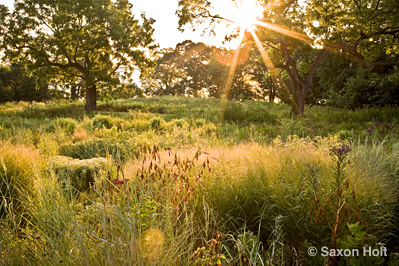
André Bluemel Meadow at River Farm
With the new book I was able to spend days and days in meadows, not often sitting but certainly watching the light as it danced off the grasses moving in the breeze. I learned even more about using light to reveal translucency and softness. Watching the dawn light reveal the sublime beauty of the meadow at The Amercan Hortucultural Society’s River Farm in Virginia gave me one of my favorite photos from the book.
I traveled to many regions to find local interpretations of grass ecologies for the American Meadows book, be they called meadows, glades, prairies, savannahs, or steppes. In Colorado I found some of the best meadow gardens, perhaps because there are such diverse native meadows in the Rocky Mountains and the plains below them. Surely the native plants have inspired the wonderful gardens at The Denver Botanic Garden (DBG), easily one of America’s very best public gardens.
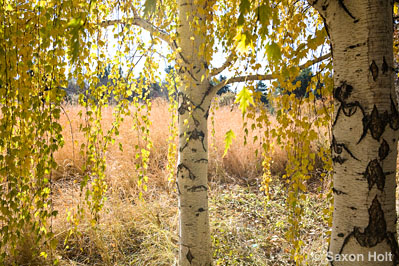
DBG meadow viewed through backlit weeping birch
I do not need Panayoti Kelaidis, their long term Senior Curator and ebullient promoter, to convince me (and anyone who will listen to him) that DBG is doing good work. There are many excellent gardens at DBG but all I need to see is the work of Dan Johnson, the Assistant Curator whose magic with grasses has created a lasting impression on me, ever since the days working on Grasses with Nan.
Recently I was in Denver working on a new book, Homegrown Herbs with Tammi Hartung. I made sure I had time to see how Dan’s grasses looked, knowing that autumn is flowering time for warm season grasses. To my absolute delight I realized the low angle of the sun on autumn days presented a great opportunity to explore back lighting. (Truth be told, I was not so delighted first entering the garden, because I had hoped for soft overcast light which is more conducive to typical garden photography.)
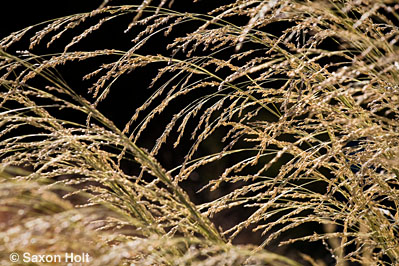
Panicum virgatum 'Dallas Blues' seedhead backlit
But as I began “seeing” back-light opportunities I began formulating this post. And now finally, I have rambled into the photo lesson.
First, back-lighting only works when the sun is low enough in the sky to be truly in “back” of your subject. Overhead midday sun is brutally contrasty, whereas low angle light can shine over top of fences, hills, houses, or shrubbery to create dark shadowy areas that can go black in the camera – if you know how to use the camera to compensate for the built-in light meter’s tendency to balance everything out to a mushy gray.

Sporobolus airoides backlit
Technically, these photos with black backgrounds might be considered underexposed, and they are – if you trusted the camera light meter. But the dynamic range of a camera (the range of detail that can be shown in dark areas versus light areas) is much more limited than the human eye. The human eye does not readily see this dramatic light, made possible by a brightly lit subject in front of a shadow area.
The photographer must shift the exposure range, aiming for a good exposure in the bright highlight area rather than some neutral point half way between shade and sun.
The further advantage of exposing the camera for the highlight area is that you can actually hold some detail in the bright areas that would otherwise be blown out.
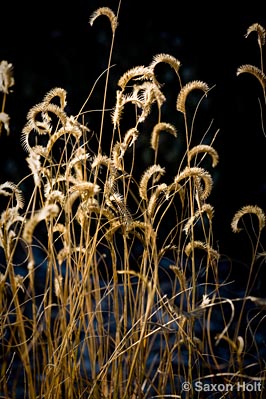
backlit seed heads blue grama grass (Bouteloua gracilis)
In an “average” exposure these seed heads would be bright blobs on a mushy gray background. Whenever you attempt this technique remember to frame your brightly lit subject in front of a uniformly dark area and be careful as you look back toward the sun that the sun is not shining directly into the camera or you will get lens flare. Though sometimes the flare can work to your advantage, like in the wide view of the André Bluemel meadow (at top) where I consciously wanted to show the sun flare as part of the composition.
The trick of exposing for the back lit highlight areas can work even when the background is not totally in shadow. Back light can be translucent, shining through foliage.
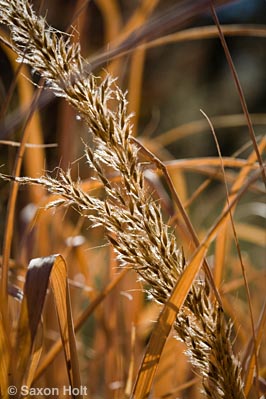
Indian Grass (Sorghastrum nutans) backlit seedhead
One must be much more careful in composition lest the highlight areas behind conflict with the main subject, but in the case where there is a uniform foliage color that is out of focus, the added color of back lit leaves adds to the story.
Or perhaps the white areas of the highlights are so dramatic that it almost makes no difference what color the background may be – so long as it is out of focus, here using a telephoto lens to make sure I had a narrow depth of field.
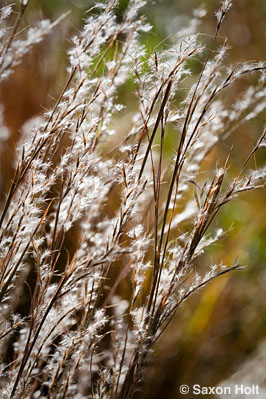
Little Bluestem (Schizachyrium scoparium)
Composition is critical with back light and one must use the negative space and dark areas to separate and silhouette the bright area.
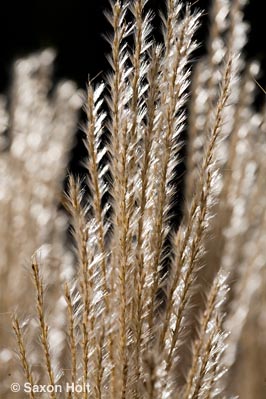
Miscanthus sinensis 'Nippon' silver backlit grass
If you have a good macro lens and can focus quite tight on a subject it is much easier to compose a photograph that has a background that is so out of focus that it does not matter if it does not go dark.
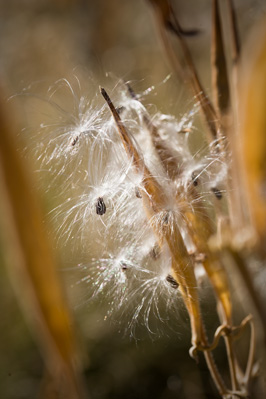
Seeds of Schyzachyrium scoparium Little bluestem
What really makes this extreme close-up photo work is a good exposure for the highlights, the white feathery seed heads. (I will confess I used Photshop to darken all the outer edgers of this photograph to give it a bull’s eye effect – drawing the eye to the white.)
And sometimes back light just works because every thing in the scene is just brilliant with light and the dynamic range of the photograph simply works. In this last one, it was just plain luck that I was able to hold the blue of the garden pond at Denver Botanic Garden with the silvery white seed bracts of the grass, still allowing some backlit color to come through the foliage.
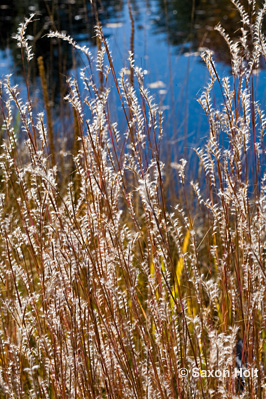
Little Bluestem grass
All in all I had about two hours of light to make these photos before the sun got too high, photographs I did not even suspect were there when I walked through the garden gates first thing that morning. It is true I have become attuned to looking for grass photo opportunities after all these years, but they never cease to thrill me.
